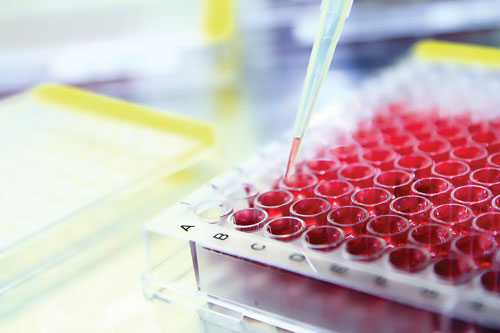Drug development would be impossible without assays. But, what are assays exactly? Assays, in short, are tests. Bioassays are the specific kinds of assays that are required in drug development. So, what kind of tests are bioassays?
In short, these are tests that are used to determine the potency and presence of any particular active ingredient in a drug. Are you wondering about the core principle behind these bioassays? Bioassays work because they recognize and measure the effect that an active ingredient has on the tissues or cells that it acts on.
Definition of Cell-Based Assay
Cell-based assays are nothing but assays (or tests) that are conducted using cells as their samples. There are various critical uses of cell-based assays. For example, cell-based assays are often used to measure the cytotoxicity of a particular active ingredient in a drug. Measuring the cytotoxicity of an active ingredient is essential before it is introduced into a drug because cytotoxic substances are detrimental or poisonous to animal cells. Without these cytotoxicity assays, a new drug cannot be introduced into the market.
That’s not all that cell-based assays are used for. It’s not enough to find out if an active ingredient is cytotoxic. It’s also essential to know what the concentration of the active ingredient in the drug should be. Cell-based assays help you find the concentration at which the active ingredient has the maximum potency. Cell-based assays also measure luminescence, radioactivity, fluorescence, and absorbance of an active ingredient.
What is the Most Crucial Element of a Cell-Based Assay?
The most important element that must be produced through a cell-based assay is a detectable signal. Without this, the presence of an active ingredient cannot be detected or measured accurately. Scientists use a variety of reagents for this purpose. It is imperative that a robust signal is produced.
The efficacy of a cell-based assay depends on the strength of this signal. Also, very importantly, this detectable signal should be reproducible. If the same active ingredient is tested in the same concentration again, a similar signal should be produced. However, this signal must not be produced during the control experiment when the active ingredient is missing.
What are the Different Varieties of Cell-Based Assays?
Various kinds of assays are used for different purposes. The term “cell-based assay” is an umbrella term that encompasses several tests or assays.
-
Cytotoxicity Assays
As mentioned above, cytotoxicity assays are used to test whether an active ingredient is actually poisonous to human cells. This is done by introducing the active ingredient in the cell colony for a certain duration.
After this period, scientists measure the number of dead and living cells. If the number of dead cells is high, the active ingredient in question is marked as cytotoxic. The FDA doesn’t allow any drug to enter the market unless it has passed through rigorous cytotoxicity assays performed by qualified experts.
-
Cell Death Assays
Cell death can happen in one of three ways: apoptosis, autophagy, and necrosis. Let’s first understand what these terms mean.
Cell-death assays are performed to obtain two key pieces of information.
- Are the cells really dead?
- Which lethal pathway did the cells follow? That is, how did they die?
Cancer research is a field where cell death assays are required extensively. Here, the key requirement is to determine whether the cell deaths have been caused due to apoptosis or not. How is this determined? By checking whether the extracellular surface of the cell membrane has been destroyed when exposed to phosphatidylserine.
Autophagy is a term that most are familiar with. There is a particular cell organelle inside the cell known as the lysosome. Lysosomes are called ‘suicide bags.’ This is because whenever any other organelle or protein is defective or injured, the lysosomes eat them up. The act of eating oneself is called autophagy. Even though it seems brutal, this is an essential process that gets rid of ineffective cell organelles so that new functioning ones can be generated.
Necrosis refers to a sort of cell death where the plasma membrane is disintegrated due to the swelling up of the cells. The swelling also leads to the death of the cell organelles inside the cell. Unlike autophagy and apoptosis, cell deaths due to necrosis cannot be pre-planned. These are accidental deaths that must be ruled out separately while performing cell death assays.
If the corpse of a cell along with its organelles is consumed by the surrounding cell, the cell death is considered complete. It is also considered complete if apoptotic fragments are found. Also, in case the cell stops functioning because of a damaged plasma membrane, it is considered dead.
-
Cell Senescence Assays
Senescence, in simple terms, means aging. Cell senescence assays are used to measure the weakening of the cell caused due to aging. The plasma membrane weakens with time as a cell ages past its prime. The aging of a cell can thus be measured by testing the integrity of the cell membrane. These assays are essential to determine how healthy and young a cell is.
Two other kinds of cell-based assays are cell-viability assays and cell-proliferation assays. The type of assay that would be best suited to your project depends on the goals and parameters that you have in mind.
Is Cell-based Assay Crucial in Drug Development?
Yes, obviously, it is. This must be amply evident from all the information provided above. You cannot send a new drug into the market without checking whether it is toxic to human beings or not. Cell-based assays have revolutionized the way drugs are developed around the world.
No longer do you have to wait for accidents to discover new ingredients for drugs and medication. You can now identify and find the perfect concentration of active ingredients through cell-based assays alone. The process of drug development has become way more controllable with cell-based assays.


